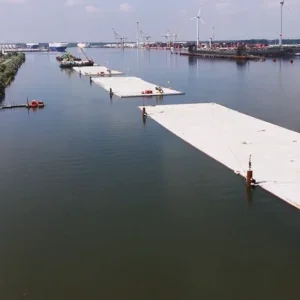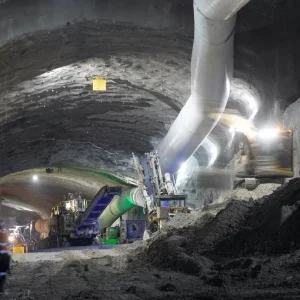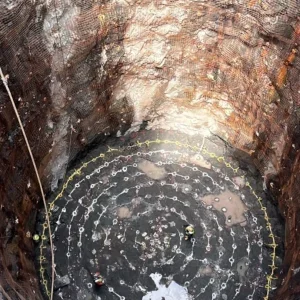The excavation of Olafsfjordur (‘Olafs’) Tunnel in the Hedinsfjordur road project, in north Iceland, is a story about water. Lots of water – cold, often at high inflow rates and high pressures. Driving through basalt with sedimentary inter-beds, the inflows mainly came through jointed dykes and fault zones scattered and clustered along the alignment.
Yet it hasn’t been the highest groundwater inflow experienced in a road tunnel excavation in Iceland. That was on the Breidadalsheidi-Botnsheidi scheme in the north west of the country in the mid- 1990s and it is still flowing. The engineers established a work-round as a permanent solution that channels off the water, for industrial and water supply use, and enabled the project to complete.
But those Metrostav tunnellers who constructed Olafs, while not experiencing rates as high, can claim to the largest inflow that has been effectively stopped during construction of a road tunnel in Iceland. Hence, the recounting of the tunnelling experience at Olafs is also a story about grout, lots of grout – cement, of course, but especially chemical resin which, unusually, would turn out to be needed in large volumes.
Geology
The geology of the mountain range through which Olafs passes comprises sub-horizontal basalts, mostly fine-to-medium grained, with porphyritic over tholeite and the olivine formations – the tunnel alignment passing entirely through the latter, except for some volcano clastic sediments, such as scoria and red sandstone. In addition, within the basalt formations there are some interbedded, near horizontal layers of fine-grained tuff.
The main joint sets are either perpendicular or parallel to the tunnel axis, but are steeply dipping. In many places the rock is heavily broken due to tectonics. The tunnel encountered many broken, brittle dykes.
There are geothermal water sources on the portal areas nearest each town, and there was the possibility for thermal inflows. But it was the opposite that was the problem – cold water which, in the worst zone, was believed to be linked through fairly open joint channels up to the ground surface with the resulting pressure, flow and chill. The danger in Olafs was that heavy inflows could reduce the natural water pressure which is utilised for hot water supply.
The surface terrain has three mountain peaks – Osbrekkufjall and the two highest, Pverfjall and Vatnsendahnjukur – with two valleys in between, the largest being Sydrardalur and also the lowest in elevation and holding the Sydra stream. It was this stream that, it is believed, is possibly linked by open joints to the strata at depth and consequently charged some of the inflows to the tunnel excavation.
However, while indicative information was obtained from surface studies it was not clear from those examinations and the limited core boreholes what was the nature, extent or detail of disruptions to the rock mass at depth. The overburden on the tunnel alignment at Olafs was up to 800m.
In all, almost two-thirds of Olafs had groundwater problems. Geological mapping of the features encountered was done by Mestrostav by Prague-based Arcadis Geotechnika, its geologist being permanently onsite.
The final geological section, after construction, shows the highest concentration of faults in the southeast, or early excavated half, of the tunnel alignment. Over this stretch there are many dykes, too, especially below Sydrardalur valley and then in the north west third of the tunnel, commencing below, and being most concentrated at, the other valley, between the two highest peaks and where overburden is most.
Getting underway
In mid-2006, Metrostav began assembling the team of 90 Metrostav workers (70 specialised, 20 engineers) in preparation to be based in remote North Iceland to build the Olafs and Siglufjordur (‘Siglu’) tunnels for the Hedinsfjordur road project. The company thought it might be reasonably possible (and was somewhat hopeful) that with its effective organisational skills and extensive construction experience it would be able to complete the works programme, scheduled to take just over three years, a little earlier.
But the unexpected ground conditions with cold inflows at Olafs would prove to be of such scale and occur over such protracted distances, that the contractor’s initial goal would not prove to be achievable. The tunnelling difficulties being experienced were examined by the client – the Icelandic Road Administration (Vegagerdin) – and its contract and technical services supervisor, consultant GeoTek.
Once the nature and scope of the problem had been established, it was agreed to be outside the contractor’s accepted and competent approach, as the client carried the geological risk as with other road tunnels in this land of variable and tectonically disrupted geology, the unit-price contract meant that the challenge, and focus, was to find the best engineering solutions.
As with practice on each blast along the drive on Olafs and Siglu tunnels, there would be discussion between Metrostav’s engineers and the supervisor to determine the agreed nature of the ground conditions and problems at specific chainages, the potential solutions to try or step-up to next, and also the degree of permanent lining support required.
The ‘Scandinavian Method’ of tunneling was used, the design and specifications based on Norwegian practice was to maximise installation of permanent support during the first pass of the excavation phase, while those support measures are themselves to be minimum in relation to the length of round, slightly over 5m. There were two support phases, first the initial support during excavation and then the permanent after breakthrough. Primary and later secondary layers of steel-fibre shotcrete, each 50mm-80mm in thickness, were applied. Permanent bolting used SN and CT bolts.
As the works advanced, and various solutions were tried and implemented, there was growing recognition and admiration from the experienced Icelandic tunnel engineers for the dedication and steadfastness of Metrostav – the sheer persistence of the company itself and the hard work of its engineers to ensure, and secure, the delivery of Olafs, and so the Hedinsfjordur project. For conditions were relatively easier on Siglu. The shorter tunnel was not throwing up such extreme groundwater conditions as being repeatedly met in Olafs.
There was a concern, however. When the Siglu drive crested on its vertical alignment and then began blasting the downhill Slope to advance closer towards Olafs, – albeit separated by a valley – might groundwater problems appear then? Fortunately, in the end, Siglu was completed without such major difficulties arising although in its last stages there were some inflows, resulting from dykes and faults.
The first hurdles
Excavation started in November 2006 on the almost 7km long mined length of Olafs. The drive would be approximately 5km uphill from the portal at Olafsfjordur. But it was not too long – approximately 800m into the drive that the first notable groundwater difficulty was encountered. Then, within a further 160m the ingress had reached more than 2000 litres per minute or approximately 33 litres per second, pressures were 10-15 bar and the water temperature was as low as 2-3 degrees C.
At this point there were no faults and the first mountain peak and valley hadn’t yet been reached overhead; dykes were the problem. The contract provides for the possibility of pre-grouting to help seal off leaks using cementitious or chemical methods with Metrostav and the supervisor having jointly assessed inflow from a pair of probe holes. The threshold inflow rate was set as 600 litres per minute (10 litres per second) to help determine between pre and post-grouting in relation to excavation. Once a pre-grouting operation had been done another, shorter pair of boreholes would be drilled to check how well the leak had been stopped.
Therefore, just over 1km into the drive it was decided to commence grouting in the front zone of the face by using cementitious grout. However, this proved unable to seal off the inflow and the contractor and supervisor agreed that polyuerethane (PU) resins be tried instead. Following confirmation of products being certified as suitable for use in area of health and environmental sensitivity, these were supplied by Minova. They had been used elsewhere in Iceland, including tunneling on the Karahnjukar hydro tunnels then under construction in east of the country.
The chemical grouting set consisted of GX-45 II pumps, BVS-40K hydropneumatic packers to fix the grouting rods in the boreholes, and CarboPur WF and WFA two- component polyurethane (PU) resin including CarboAdd Thix 1 and 2 accelerators. Minova trained select Metrostav crew in both the theory and practice of working with the chemical grout systems, which would require procedures (such as pre-heating) as well as the drill patterns to be adjusted to handle different inflow rates, geology and technical condition for application of the product.
In addition, Metrostav was able to call upon the services of a grouting consultant, Tomasz Najder, as recommended by the client’s supervisor and also working then in Iceland dealing with inflows challenges on the Karahnjukar tunnels. Metrostav’s project director, Ermin Stehlik, says due to those many challenges on Karahnjukar the contact with Najder was often phone, fax or email.
The contractor also installed intercepting traps both within the tunnel and at the portal to catch any chemical leaks, if necessary.
At 1km into the drive on Olafs, therefore, the approach was recommended to be to drill 16-18 probe holes ahead of the face, of 12m-20m lengths, from around its circumference. The holes would then be used to inject the PU grout, which was to form a protective ring-barrier against inflows. This approach was used over a section of approximately 80m and took 1.5 months, completing in July 2007.
Even tougher ahead
However, the following month, more than 800m further into the drive, the PU grouting was to be called upon once again for probe holes had found groundwater pressures up to 30-32 bar, and there were fissures and cracks up to 500mm wide in the rock mass ahead.
A higher performance SK-90 rotary gear-type pump was introduced, plus a suitable compressor for compressed air, and Geofoam foam-producing resin was added to the materials options. Dedicated boreholes would be added to the drill pattern to pierce and attempt to fill the larger voids with the foam. A CT-PM high performance electric pump was also prepared on site, though eventually was not called upon.
There was also the challenge of having a sufficient stock of the PU resins for both the application rate, and volumes needed, would be higher than earlier in the drive. The time taken to source and have delivery to near the Arctic Circle on Iceland of repeated, large truck loads of non-stackable cans of PU resins would be a factor that led to further delay in the programme.
Then, about 340m further ahead, a fault was encountered with pronounced tectonic breccia of stones up to 500mm with clayey-sandy matrix. First met on the left of the face, the breccia zone was exposed to take up the entire left half of the area as the drive advanced only 4m. On the right was altered scoriaceous basalt with a sedimentary inter-layer. The clayey fill was blocked the drill bits. Large inflows of 600-1200 litres per minute were found during rock bolting beforehand and from probe holes. No jets of water came out the face, only a continual extreme wetness, which prevented application of steel-fibre shotcrete.
As a consequence, the solution concept was to view the material as soil. An array of nine 12.6m long, 51mm diameter boreholes were drilled, splaying outside the profile area and PU resin injection significantly reduced the flows leaving the remainder to be drained by intermediate boreholes. Mesh and shotcrete were applied. Where rock bolting met water, there were parallel bore drilled for drainage set about 500mm away, a packer fitted and grouting undertaken that would enable the rockbolt to then be filled with grout.
Further ahead, worse was to come – single probe holes unleashing cold water flows of up to 2500 litres per minute with relatively constant pressures of 24-29 bar. The inflow was coming below Sydrardalur valley where the basalt overburden was found to be intensely fractured. This would be one of the worst areas on Olafs. Fissures were 2-50mm with clayey fill and there were crushed zones with clearly defined slickenslides. Beyond this section there was a tectonic breccia of stones in clayey sand.
However, in July 2008, on a section of the tunnel there was a point where inflows were so severe, reaching about 500 litres per second that pre-grouting was impossible and the tunnel was subsequently flooded, but only for a period, whereas the inflow decreased significantly within a few days.
Stehlik says: “The difficult part was that sometimes we thought that the worst was behind us, everything worked well, but all of a sudden we would hit the water again.” He adds that tonnes of PU resin was being used daily and there was the further incredible sight of large stocks of the expensive, but highly effective product, rapidly depleting, knowing it takes six weeks to get more to Iceland.
Completing the challenge
Breakthrough in April 2009, meeting the Siglu crew who had crossed the valley and blasted on an uphill drive to close the gap. However, given the experience of Olafs, should they have reached the crest first then there was the risk of proceeding into a downhill slope.
So, with this potential foreseen early on and no-one wanting a submerged face, it was agreed with the client sufficiently in advance to drop the vertical slopes for the drive in Olafs from Hedinsfjordur valley, and consequently shifting the crest to the south east by some five hundred metres, and so continuing giving both crew uphill drives.
Two Sandvik Axera drill rigs were used on the project, one per tunnel, and drilled a total of 40km of holes for pre-grouting and 32km of probe holes – both with 51mm diameter. The blasting holes were 48mm diameter. The drill rigs proved very reliable and were a good choice for the conditions, said the contractor.
With no access adits along the drives, the ventilation system was designed as a separate blowing set up. On Olafs it was provided by 1 x 1800mm and 1 x 2100mm diameter non-reinforced ducts and two axial Cogemacoustic, type T2 180 ventilators with frequency converters for regulation suited to tunnel length.
The absence of an adit also presented a challenge to move construction equipment to the face as well as mucking out. A dumper was used for transport. For mucking out, initially working with a loader brought a few problems, such as high breakdown rate, mainly with operator training. That was overcome and loader performance is much better than wheel loaders, says the contractor. It was used for excavating the invert and the first scaling operation.
While the best month’s advance on Olafs was 330m – higher than in Siglu – the average was reduced to less than 180m over the 3km stretch of drive with inflow problems.
After negotiation between the client and contractor, the extra time needed and financial cover for the additional works dealing with the severe groundwater complications, the target for completing the entire project was moved to the end of September 2010 from an original date of late 2009. There was also a separate agreement by the client that helped to partly offset the exchange rate difficulty brought by the economic problems that shook Icelandic and the consequent drop in the value of its currency.
The Hedinsfjordur road project was officially opened on 2 October.
The challenges faced by Metrostav and the solutions used were discussed in February 2010 at a presentation by Ermin Stehlik to the British Tunnelling Society (BTS) in London and since have been shared with visiting tunnellers to Prague.
Recalling the BTS talk, Martin Knights, global tunnelling director with Halcrow Group and past president of the International Tunnelling and Underground Space Association (ITA), praised the presentation for being both highly informative and enjoyable. Not least, the assembled tunnellers were presented with an uncommon addition to a BTS talk – video footage of tunnelling work under extreme conditions, made at a face in Olafs where there was heavy groundwater inflow, and all set to classical Czech music composed by Smetana. The soundtrack of AC/DC accompanies another video presentation showing blasting and other activities in Olafs Tunnel.
Knights says: ‘The Project presentation was first class and respected the audience’s needs—to be informative, interesting, honest (in that problems were clearly explained as were the consequential solutions) and it was very entertaining.
‘The project presentation had many sub-themes regarding the construction of the underground works including water ingress problems. These issues were well explained – even with the appropriate musical background!
‘Clearly the speaker had prepared the presentation well and had mastered the art of storytelling of a complex technical subject for an English speaking audience. No mean feat!
‘BTS is indebted to Mr Stehlik for a well researched and presented presentation—in fact the presentation was so comprehensive there were very few questions forthcoming after Ermin`s presentation—he should take that as a compliment!’
Groundwater problems quickly arose in Olafs, just over 1km into the first drive and then didn’t let up for another 3km. Soon chemical grout was required Olafsfjordur (Olafs) Tunnel on the Hedinsfjordur road project, in north Iceland, called for almost 7km of mined tunnel to be blasted through a mountain range with basalts and sedimentary inter-beds that turned out to have many jointed dykes and faults The severe groundwater problems sometimes seeped and soaked the excavation face… …and at other times, and from other ground, erupted as a high pressure jet …or many jets as more difficult locations was reached A drive from Hedinsfjordur valley to blast Olafs from the opposite direction started in May 2008 but at a shallower slope than first planned to give longer distance uphill and avoid any downhill grade risk with groundwater before breakthrough underground Outside the water froze and it snowed, inside the tunnel and the work went on Celebrating the underground breakthrough, in April 2009, when two uphill drives met completed the challenging excavation of Olafs







